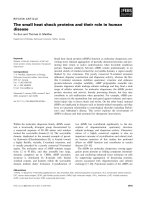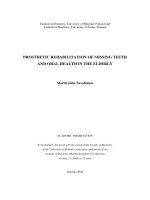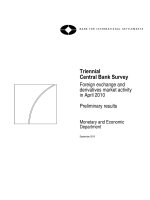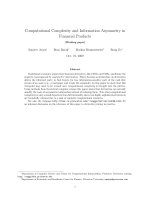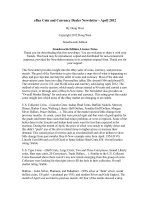Issue 91 – Regulatory and Tax Developments in April 2012 pptx
Bạn đang xem bản rút gọn của tài liệu. Xem và tải ngay bản đầy đủ của tài liệu tại đây (357.4 KB, 9 trang )
1
FUND NEWS
April 2012
Investment Fund Regulatory and Tax developments in
selected jurisdictions
Issue 91 – Regulatory and Tax
Developments in April 2012
Regulatory News
European Union
ESMA begins AIFMD co-operation
discussions with non-EU supervisors
On 26 April 2012 the European
Securities and Markets Authority
(ESMA) announced that it will begin
discussions with non-EU supervisors of
entities subject to requirements of the
Alternative Investment Fund Managers
Directive (AIFMD) about supervisory co-
operation issues. ESMA will lead on the
negotiation of co-operation
arrangements with non-EU authorities
on behalf of EU supervisors. This will be
done through a common Memorandum
of Understanding (MoU), which will
Regulatory Content
European Union
ESMA begins AIFMD co-operation
discussions with non-EU authorities
Page 1
ESMA final advice on possible delegated
acts concerning the Short-Selling
Regulation Page 2
Reports on Implementation of the third
Anti-Money Laundering Directive Page 2
Ireland
Industry Guidance on Global Exposure
Disclosure in Annual Report Page 3
Central Bank consults on Market Abuse
Page 3
Luxembourg
SIF requirements for Risk and Conflicts of
Interest Management Page 3
UK
FSA augments its rules regarding the
circumstances when an OEIC is wound up
or a sub-fund terminated Page 3
International
IOSCO consults on MMF Systemic Risk
Analysis and Reform Options Page 4
IOSCO consults on Principles for Liquidity
Risk Management for CIS Page 5
Tax Content
UK
2012 Budget Page 6
HMRC issues draft guidance on the new
UK ITC tax regime Page 6
Venture Capital Trusts – Finance Bill 2012
changes Page 6
Fund News – April 2012
2
facilitate the cross-border supervision of
those entities subject to AIFMD such as
managers of alternative investment
funds, depositaries and entities
performing tasks under delegation by
the manager.
The MoU will be based on IOSCO’s
Principles Regarding Cross-Border
Supervisory Co-operation.
www.esma.europa.eu/AIFMD
ESMA published final advice on
possible delegated acts concerning
the Short-Selling Regulation
On 19 April 2012 ESMA published its
final advice on possible delegated acts
concerning the Regulation on Short-
Selling and certain aspects of Credit
Default Swaps (CDS) (EU No 236/2012)
that will enter into force on 1 November
2012.
Section I of the advice specifies the
definition of when a natural or legal
person is considered to own a financial
instrument for the purposes of the
definition of short sale.
Section II relates to the net position in
shares or sovereign debt covering the
concept of holding a position, the case
when a person has a net short position
and the method of calculation of such a
position including when different entities
in a group have long or short positions or
for fund management activities related
to separate funds.
Section III sets out the advice on the
cases in which a CDS is considered to
be hedging against a default risk or the
risk of a decline of the value of the
sovereign debt and the method of
calculation of an uncovered position in a
CDS.
Section IV defines the initial and
incremental levels of the notification
thresholds to apply for the reporting of
net short positions in sovereign debt.
Section V specifies the parameters and
methods for calculating the threshold of
liquidity on sovereign debt for
suspending restrictions on short sales of
sovereign debt.
Section VI sets out what constitutes a
significant fall in value for various
financial instruments and also specifies
the method of calculation of such falls.
Section VII specifies the criteria and
factors to be taken into account by
competent authorities and ESMA in
determining when adverse events or
developments arise.
ESMA’s final advice is available via the
following web link:
www.esma.europa.eu/Short Selling
Reports on Implementation of the
third Anti-Money Laundering
Directive
During the month of April 2012 the Joint
Committee of the three European
Supervisory Authorities (EBA, ESMA and
EIOPA) published two reports on the
implementation of the third Money
Laundering Directive. The “Report on
the legal, regulatory and supervisory
implementation across EU Member
States in relation to the Beneficial
Owners Customer Due Diligence
requirements”
(here) analyses EU
Member States’ current legal, regulatory
and supervisory implementation of the
anti-money laundering/counter terrorist
financing (AML/CTF) frameworks related
to the application by different credit and
financial institutions of Customer Due
Diligence (CDD) measures on their
customers’ beneficial owners. The
“Report on the legal and regulatory
provisions and supervisory expectations
across EU Member States of Simplified
Due Diligence requirements where the
customers are credit and financial
institutions” (
here) provides an
overview of EU Member States’ legal
and regulatory provisions and
supervisory expectations in relation to
the application of Simplified Due
Diligence (SDD) requirements.
Fund News – April 2012
3
Ireland
Industry Guidance on Global
Exposure Disclosure in Annual
Reports
The Irish Fund Industry Association
(IFIA) has issued a technical paper on
“Annual Financial Reporting
requirements around the disclosure of
Global Exposure under UCITS IV.” The
paper gives practical guidance on issues
such as how to find the required
information for the disclosure and on
whether global exposure should be
disclosed as part of the FRS 29 note.
The paper is available in the members’
area of the IFIA website –
www.irishfunds.ie
Central Bank consultation on Market
Abuse
The Irish regulator, the Central Bank of
Ireland, has issued Consultation Paper
58 on “The Handling of Inside
Information under the Market Abuse
(Directive 2003/6/EC) Regulations
2005.” The consultation paper deals
with three issues:-
1 Determining what information is
sufficiently significant for it to be
deemed inside information.
2 Types of insider list.
3 Director and personal account
dealing and the definition of persons
discharging managerial
responsibility.
The consultation closes on 14 June
2012.
Luxembourg
Specialised Investment Funds (SIF)
requirements regarding Risk
Management and Conflicts of Interest
On 20 April 2012 the Commission de
Surveillance du Secteur Financier (CCSF)
issued a Press Release providing further
information on the new requirements in
relation to risk management and
conflicts of interest management for
Specialised Investments Funds (SIF).
These new requirements were
contained in the amendments to the SIF
law that came into force on 1 April 2012.
Pending the release of a Regulation on
these areas, the CSSF has clarified that
all new application files submitted to the
CSSF must contain a brief description of
the risk management process and
systems to identify, measure, manage
and control all material risks. Each SIF
must also submit a document that
describes how potential conflicts of
interest are managed.
These documents must have been
approved by the governing body of the
SIF. Those SIFs in existence prior to 1
April 2012 will have to submit these
documents before 30 June 2012.
The full text of the press Release is
available via the following web link:
UK
FSA augments its rules regarding the
circumstances when an OEIC is
wound up or a sub-fund terminated
In March the Financial Services Authority
(“FSA”) adopted extended rules for
Open-Ended Investment Companies
(“OEICs”) and OEIC sub-funds which
require that a sub-fund termination or
the winding up of an OEIC is required to
commence following either: an OEIC’s
or sub-fund’s scheme of arrangement or
merger; or, for an umbrella OEIC, where
there are schemes of arrangement for all
the remaining sub-funds then the
umbrella OEIC must be wound up. The
augmentation of COLL Rule 7.3.4(4)
affirms that the expectation of the FSA,
set out in CP11/18, is that when all sub-
funds are terminated and an umbrella
OEIC has become an “empty shell” it
must be wound up and that it is not
possible or permissible to populate that
OEIC with new sub-funds.
The change in the COLL Rule 7.3.4 (4)
through the addition of paragraphs d), e)
and f) took effect from 22 March.
Accordingly, it will generally be the case
that as part of the project to undertake
schemes to merge funds the Authorised
Corporate Director (“ACD”) should
consider the timing of the discontinuing
fund’s termination. Sub-fund
termination remains a separate process
as set out in FSA COLL Rules and
continues to require: the assessment of
solvency of the sub-fund or the OEIC;
preparation of the solvency statement;
obtaining the auditor’s opinion on the
enquiry made by the ACD into solvency;
and the completion and submission of
Fund News – April 2012
4
Form 21 (Notification of certain changes
for an OEIC). The FSA assess that it
should no longer be appropriate to
complete a scheme and then defer for
an extended period the application to
terminate a sub-fund or wind up an
OEIC.
Schemes of arrangement will generally
result in the sub-fund, or OEIC, being in
the position of ceasing to hold scheme
property, and this is the assessed
circumstance after a scheme: even if
cash is retained to meet accrued
liabilities and creditors; and including
where, after collecting outstanding
debts and settling liabilities, there is a
residual amount that is paid to or
received from the successor fund in
accordance with the scheme of
arrangement.
While in many cases the logical date to
start the termination is immediately after
the scheme has been completed the
FSA has said this is not a condition of
the new rule. ACDs should, including
for schemes in progress that will be
executed after 22 March, plan to comply
with revised COLL as part of the fund
merger plans. However, the timelines
for solvency assessment and reporting
to FSA are very specific the FSA have
said the new rule does not mean that
the termination must become part of the
scheme. As the other termination rules
have not changed, if the ACD plans to
commence the termination immediately
after the scheme is executed then the
ACD must deliver the solvency
statement to the FSA and sufficiently
ahead of the scheme date so that the
FSA is able to approve the termination
on or before the scheme date. This may
be before the scheme is approved by
unitholders as the two processes have
different time lines.
The subsequent timeframe for
completing the sub-fund termination
remains flexible, there can be no
prescription as to how long the
termination might take, reflecting that it
is uncertain how long it will take to
collect debts and agree and settle
creditors. That said, completing the
termination and the termination account
efficiently can minimise the costs and
reduce unnecessary future financial
reporting for sub-funds with no
unitholders.
Additional to this amendment to COLL,
the FSA Handbook Notice 118 has also
provided: additional guidance to
determine the eligibility of interests in
syndicated loans; made minor
amendments consequent on
implementing UCITS IV, and corrections
of cross reference errors that arose
when UCITS IV was reflected in COLL.
Details are contained in Handbook
Notice 118 (91 pages) and can be found
on pages 16 and 17; and 23 to 29 of the
document which is available via this web
link:
/>ook/hb-notice118.pdf
International
UK
International
IOSCO consults on Money Market
Fund (MMF) Systemic Risk Analysis
and Reform Options
The International Organisation of
Securities Commissions (IOSCO)
released a consultation report outlining
the possible risks that MMFs could pose
to systemic stability, and consulting on a
range of policy options to address these
risks. MMFs account for 20% of the
assets of Collective Investment
Schemes worldwide and are a
significant source of credit and liquidity.
The systemic importance of the MMF
sector is described in terms of their
importance and interconnectedness with
the rest of the financial system,
susceptibility to runs, the importance in
short-term funding and contagion
effects, links with sponsors, importance
for investors as a cash management
tool.
The policy options considered in the
paper include:
• A mandatory move to variable NAV
funds and other structural
alternatives such as NAV buffers,
insurance or conversion to special
purpose banks;
• Capital and liquidity requirements for
constant NAV MMF;
• Reserving constant NAV MMF
either for retail or institutional
investors;
• General principle of mark-to-market
Fund News – April 2012
5
valuation and restricted use of
amortised cost;
• Liquidity management including
portfolio liquidity requirements,
know your shareholder to better
anticipate cash outflows,
redemption restrictions, liquidity
fees, minimum balance
requirements, valuation at bid,
redemption-in-kind, gates and
private emergency liquidity facility;
• Reduce the reliance on ratings by
removing reference to ratings from
regulation, and encourage greater
differentiation in ratings in the MMF
population;
Comments on the consultation report
are due by 28 May 2012. IOSCO is
expected to elaborate its policy
recommendations by July 2012.
The 74 page report is available via the
following web link:
www.iosco.org
IOSCO consults on Principles for
Liquidity Risk Management for
Collective investment Schemes
On 26 April 2012 the IOSCO issued a
consultation on principles of liquidity risk
management for Collective Investment
Schemes (CIS). The aim of this
consultation is to outline principles
against which both the industry and
regulators can assess the quality of
regulation and industry practices
concerning liquidity risk management.
The report differentiates between
principles applicable to the pre-launch
and the post-launch phases of a CIS.
In the pre-launch phase a CIS should:
• draw up an effective liquidity risk
management process;
• set appropriate liquidity limits which
are proportionate to the redemption
obligations and liabilities of the CIS;
determine a suitable dealing
frequency for units in the CIS;
• include the ability to use specific
tools or exceptional measures which
could affect redemption rights in the
CIS’s constitutional documents such
as exit charges, limited redemption
restrictions, gates, dilution levies, in
specie transfers, lock-up periods,
side letters which limit redemption
rights or notice periods;
• consider liquidity aspects related to
its proposed distribution channels;
• have access to, or can effectively
estimate, relevant information for
liquidity management;
• ensure that liquidity risk and its
liquidity risk management process
are effectively disclosed to
prospective investors
In the post-launch day-to-day liquidity
risk management the CIS should
• effectively perform and maintain its
liquidity risk management process,
which should be supported by
strong and effective governance;
• regularly assess the liquidity of the
assets held in the portfolio;
• integrate liquidity management in
investment decisions:
• identify an emerging liquidity
shortage before it occurs;
• incorporate relevant data and factors
into its liquidity risk management
process in order to create a robust
and holistic view of the possible
risks;
• conduct assessments of liquidity in
different scenarios, including
stressed situations
• ensure appropriate records are kept,
and relevant disclosures made,
relating to the performance of its
liquidity risk management process
Comments on the consultation report
are due by 2 August 2012.
Fund News – April 2012
6
Tax
UK
2012 Budget
On 21 March, the Chancellor announced
the 2012 Budget. The announced
measures included a reduction in the
main rate of UK corporation tax, a
reduction in the highest rate of income
tax and a carve out of the UK controlled
foreign company rules for certain
offshore funds.
The Chancellor announced a reduction in
the main rate of corporation tax to 24%
from 1 April 2012 rather than the
expected 25%. The originally proposed
1 percent reductions until 2014 will then
continue so that the rate is 23% from 1
April 2013 and 22% from 1 April 2014.
For individuals, the top rate of income
tax will fall from 50% to 45% from April
2013.
On 29 March the Government published
the Finance Bill 2012 which contains
amended controlled foreign companies
(CFC) legislation. There are carve outs
for companies providing seed capital to
certain offshore funds. Under the
proposed legislation, an offshore fund
will not be a CFC provided that the
following conditions are met:
• The genuine diversity of ownership
condition (i.e. that the fund is not a
private fund).
• Taxable profits that would otherwise
be attributable to the UK company
are less than £500,000.
• The UK company in question is the
investment manager (or associated
to the investment manager) and
receives management fees from the
offshore fund.
HMRC issues draft guidance on the
new UK ITC tax regime
HM Revenue & Customs (“HMRC”)
published draft guidance on 20 March
2012 in connection with the new UK
Investment Trust Company (“ITC”) tax
regime that has effect for accounting
periods beginning on or after 1 January
2012. The guidance provides additional
detail regarding how the new regime will
operate in practice. The rules of the
new regime are contained in both the
revised section 1158 of the Corporation
Tax Act 2010 and The Investment Trust
(Approved Company) (Tax) Regulations
2011 (“the Regulations”). Comments
on the draft guidance should be provided
to HMRC by 1 June.
The main points of interest arising from
the draft guidance are:
• There will be a pro-forma application
form for those companies that wish
to make an application to enter the
new regime.
• As anticipated, HMRC has provided
explicit confirmation that an
investment trust listed under
Chapter 15 of the UK Listing Rules
will be treated as compliant with
condition A outlined in section 1158
of CTA 2010 (the “spread of risk”
test). Only in exceptional cases will
a company so listed be treated
otherwise (the draft guidance gives
the example of a regulatory enquiry).
For investment trusts that are not
Chapter 15 listed, the draft guidance
states that HMRC will apply a
similar approach to that outlined in
the listing rules to ensure there is a
level playing field across the sector.
Non-Chapter 15 listed companies
should consider whether their
published investment policies would
meet the requirements of the
Chapter 15 rules when making an
application to enter the regime.
• It is confirmed that, for the purposes
of the income distribution
requirement, income will generally
be taken to be the gross statutory
income computed in accordance
with tax principles and before the
deduction of income tax, corporation
tax and management expenses
subject to a few specific rules
detailed in regulation 20 of the
Regulations.
• The draft guidance provides a
helpful example of the additional
distribution that an investment trust
may be required to pay in the
situation where it has accounted for
an amount of reported income from
an offshore fund in capital but has
insufficient current year revenue
profits to pay the additional dividend
that might be required to be paid
under regulation 21 of the
Regulations. The guidance states
that the investment trust would be
required to pay a dividend from
reserves. HMRC should provide
clarification of whether it would be
permissible to pay that dividend
Fund News – April 2012
7
from either a brought forward
revenue reserve, a brought forward
capital reserve or a current year
realised capital profit (or a
combination thereof).
• The new regime does not prohibit
the distribution of gains realised on
the disposal of investments as
dividend.
• The Regulations are clear that any
breach for which there was no
reasonable excuse; or which was
not inadvertent; or which was not
corrected as soon as reasonably
practicable, would be a serious
breach. The draft guidance states
that such a breach would normally
require some deliberate action (or
deliberate non-action) or neglect and
confirms that a failure to notify a
breach to HMRC would be viewed
as a serious breach, even if action
had been taken to remedy the
breach in question. It is a
requirement of the Regulations that
all breaches must be notified in
writing to HMRC as soon as
reasonably practicable.
• The draft guidance confirms that
there is no time limit for HMRC to
issue a notice to an investment trust
that it has committed a serious
breach of the requirements of the
new regime. This could result in a
loss of investment trust approval
from the start of the accounting
period in which the breach occurred
as well as all subsequent accounting
periods. Therefore it is crucial that
investment trusts establish
appropriate systems and controls to:
prevent any occurrences of a breach
of the requirements of the new
regime (especially serious
breaches); and identify any breaches
as soon as they occur so that they
can be remedied without delay and
notified to HMRC.
Link to the draft guidance (33 pages):
/>guidance.pdf
Venture Capital Trusts – Finance Bill
2012 changes
The Finance Bill 2012 makes a number
of changes to the Venture Capital Trusts
(“VCTs”) tax regime in the UK, some of
which were trailed during 2011.
However, certain additional significant
changes were announced in the Finance
Bill itself, including a change which
creates a new risk that VCTs could
potentially lose their tax-favoured status.
The loss of such status could have
serious consequences for investors.
The new measures
VCTs will be subject to a new condition
prohibiting them from making an
investment in a company which
breaches the annual investment limit
applicable to funds raised through
venture capital schemes (including other
VCTs; the Enterprise Investment
Scheme (“EIS”); and other similar
schemes).
If the limit is exceeded, the VCT would
lose its overall status as a VCT
(regardless of the size of its holding in
the investee company in question, or the
extent to which the limit was breached),
this is at variance to the current position
where only the qualifying status of the
investee company in question would be
jeopardised.
This new condition will apply in respect
of investments made by the VCT on or
after the date of Royal Assent of the
Finance Bill. However, funding obtained
by an investee company from other
venture capital schemes in the previous
12 months will still be taken into account
in determining whether an investment
made after that date breaches the
investment limits condition (even if the
previous 12 months includes a period of
time before the date of Royal Assent). It
significantly increases the risk of VCTs
investing in companies, and highlights
the need for due diligence prior to any
investment. The consequences of a
breach (potentially through no fault of
the investing VCT itself) could result in
the VCT losing its tax-favoured status, as
well as investors in the VCT having their
initial income tax reliefs clawed back by
HMRC.
In addition, there is no concept of
‘protected money’ in the context of the
new condition. Under the previous
rules, VCT money raised prior to 6 April
2007 could be invested in a company
without risk of breaching the £2million
investment limit.
The annual investment limit is being
raised from £2million to £5million,
subject to obtaining State Aid approval.
Previously announced changes
The gross assets limit for investee
companies is raised to £15million from
£7million (immediately before
investment), and the permitted number
of employees is raised to 250 from 50.
These increases are subject to State Aid
approval.
The maximum qualifying investment
restriction (£1million annually) has been
Fund News – April 2012
8
removed, unless there are certain joint
venture or partnership arrangements in
place. These changes broaden the
scope for potential investee companies
to raise finance from VCTs.
There is a new excluded activity for
investee companies, which will no
longer be able to raise VCT funds if they
receive feed-in tariffs in connection with
the subsidised generation or export of
electricity (although there are some
exceptions to this). Shares issued by an
investee company before 23 March
2011 will not be affected by this change;
nor will shares issued after that date
where the generation or export of
electricity began before 6 April 2012.
Anti-avoidance measures
Investee companies will no longer be
able to use VCT funds to acquire shares.
There is also a new ‘no disqualifying
arrangements’ requirement, which will
apply if either:
the “whole or the majority” of the
funding raised is paid to, or for the
benefit of, a party to the arrangements
(or a person connected with such a
party); or
in the absence of the arrangements it
would have been reasonable to expect
that the qualifying business activity
would have been carried on as part of
another business by a person party to
the arrangements (or a person
connected with such a party).
Arrangements can be disqualified even if
the investee company is not party to the
arrangements
Schedule 8 of the Finance Bill, which
contains the VCT provisions, is available
via this web link (scroll to the bottom of
the page for Schedule 8 and then use
the continue button for subsequent
paragraphs):
/>a/bills/cbill/2010-2012/0325/12325.262-
268.html
KPMG’s annual
surveys Funds
and Fund
Management and
Hedge Funds –
now online
KPMG International has collaborated
across our member firms to provide you
with the annual International Funds
and Fund Management Survey and
the annual International Hedge Funds
Survey that can help you navigate the
changing environments in which we
work.
Country by country, you can read about
the latest accounting, tax, and regulatory
issues to gain the accurate and relevant
information you need.
The 2012 version of our International
Funds and Fund Management Survey
survey is available via the following web
link: Funds
The 2012 version of our International
hedge funds survey is available via the
following web link: Hedge Funds
Fund News – April 2012
9
Contact us
Dee Ruddy
Senior Manager
T: + 352 22 5151 7369
E:
Audit
Nathalie Dogniez
Partner
T: + 352 22 5151 6253
E:
www.kpmg.lu
Publications
Tax
Georges Bock
Partner
T: + 352 22 5151 5522
E:
Advisory
Vincent Heymans
Partner
T: +352 22 5151 7917
E:
The information contained herein is of a general nature and is not intended to address the circumstances of any particular individual or entity. Although we endeavour to provide accurate and
timely information, there can be no guarantee that such information is accurate as of the date it is received or that it will continue to be accurate in the future. No one should act on such
information without appropriate professional advice after a thorough examination of the particular situation.
© 2012 KPMG Luxembourg S.à r.l., a Luxembourg private limited company, is a subsidiary of KPMG Europe LLP and a member of the KPMG network of independent member firms affiliated with
KPMG International Cooperative (“KPMG International”), a Swiss entity. All rights reserved. The KPMG name, logo and “cutting through complexity” are registered trademarks or trademarks of
KPMG International.
A Disputed
Proposal: An
Overview of the
Financial
Industry's
Response to the
Volcker Rule
here:
UCITS IV - Fill the
glass to the brim
II: have we
broken through?
An update on the
tax implications
of UCITS IV
here
Charles Muller
Partner
T: +352 22 5151 7950
E:
The value of the
hedge fund
industry, to
investors,
markets, and the
broader economy
here:



